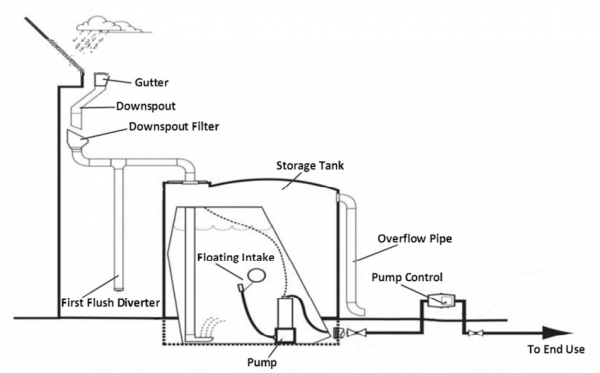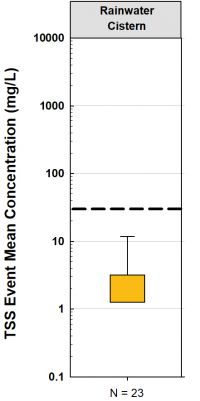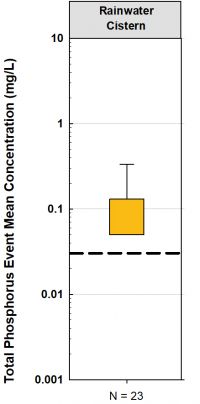Rainwater Harvesting: Performance
TSS Reduction[edit]
The performance results for Rainwater harvesting practices, located within TRCA's watershed originate from fours sites:
- Minto Hotel (Toronto)
- Metro Label 1 (Scarborough)
- Metro Label 2 (Scarborough)
- Brookside P.S (Scarborough)
The mean performance value recorded at each of the rainwater cistern practices, was to measure their ability to remove Total Suspended Sediments (TSS), which was calculated based on 24 separate recordings from 2007-2010 at each of the aforementioned locations listed above.
As can be seen in the corresponding boxplot the mean performance removal efficiency of the rainwater cistern practices monitored are well below the suggested guideline of 30 mg/L (Canadian Water Quality Guideline (CWQG), or (background (assumed at <5 mg/L)+ 25 mg/L for short term (<24 hour) exposure) (CCME, 2002[1]; (TRCA, 2021[2]).
The median value of the 24 samples taken was 1.25 mg/L whereas the mean was 3.98 mg/L, with a 4% guideline exceedance.
Phosphorus Reduction[edit]
The performance results for Rainwater harvesting practices, located within TRCA's watershed originate from fours sites:
- Minto Hotel (Toronto)
- Metro Label 1 (Scarborough)
- Metro Label 2 (Scarborough)
- Brookside P.S (Scarborough)
The mean performance value recorded at each of the rainwater cistern practices, was to measure their ability to remove Total Phosphorus (TP), which was calculated based on 24 separate recordings from 2007-2010 at each of the aforementioned locations listed above.
As can be seen in the corresponding boxplot, the mean performance removal efficiency of the infiltration trench practice monitored is not meeting the acceptable upper extent range of nutrients as it is 0.03 mg/L (30 µg/L) (Environment Canada, 2004[3]; OMOEE, 1994[4]).
The median value of the 24 samples taken was 0.05 mg/L whereas the mean was 0.11 mg/L, with a 100% guideline exceedance. Given the small sample size of just 24 grab samples further monitoring projects will be required to ensure that the results collected are as accurate as possible to ensure these practices can meet federal and provincial governments' guideline requirements for TP stormwater quality.
Please refer to the Phosphorus page and the additives page for more information on how LIDs can reduce contaminant loading in stormwater
Recent Performance Research[edit]
- (O'Hogain et al. 2012) - Physicochemical and microbiological quality of harvested rainwater from an agricultural installation in Ireland
- This research study conducted by the Dublin Institute of Technology was commissioned by the federal government to assess the feasibility of utilizing rainwater to replace treated mains for non-potable uses (bathing, irrigation, etc.) on an agricultural property. Two different rainwater harvesting configurations were developed and the results collected over a 1-year period found that median TSS levels were 3.0 mg/L for configuration 1 and 3.5 mg/L for configuration 2. The only parameter that did not comply with local drinking water regulations were the levels of iron, lead and ammonia collected in the cistern of configuration 1 and just ammonia for configuration 2 (O'Hogain et al. 2012[5]).

- (Knights et al. 2012) - Can rainwater tanks meet multiple sustainability objectives?
- This paper presents results of a study that highlight the benefits of rainwater tanks and harvesting systems in urban environments. The results come from real-time metering and usage of rainwater by a household that is a part of a rainwater tank program in Marrickville, Australia. 10 samples were taken from the tank and found that a mean level of 5 mg/L of TSS was found, while 0.054 mg/L was found for TP. The removal total for hte tank on an annual basis was found to be 240,000 mg/yr (TSS) and 2,000 mg/yr of TP (Knights et al. 2012[7].
- (Kus, et al. 2011) - Water Quality in Rainwater Tanks in Rural and Metropolitan Areas of New South Wales, Australia
- This study compared RWH in Sydney and Kangaroo Valley, Australia and their ability to remove common pollutants found in rainwater collected from rooftops. TSS rates ranged predominately between 0.5 - 3.5 mg/L in most Sydney-area RWH tanks, but increased to +5.5 mg/L in others that were above local turbidity levels set by the Australian Guidelines for Water Recycling (AGWR). Meanwhile all samples taken from New South Wales based RWH never exceeded 1.0 mg/L. Additionally the authors conducted experiments on collected rainwater from a typical domestic roof in Sydney, New South Wales and treated it with an adsorption pretreatment filter media system of granular activated carbon (GAC), followed by micro-filtration. The influent rainwater was quite low already (1.2 mg/L), but the GAC pretreatment achieved an average reduction to 0.79 mg/L (~34% removal efficiency) removal efficiency and with the membrane filtration it reduced TSS to less than 0.5 mg/L (below instrument detection limits). therefore removal efficiency couldn't be accurately applied but greater than 58% (Kus, et al. 2011[8]).
References[edit]
- ↑ Canadian Council of Ministers of the Environment (CCME). 2002. Canadian water quality guidelines for the protection of aquatic life: Total particulate matter. In: Canadian Environmental Quality Guidelines, Canadian Council of Ministers of the Environment, Winnipeg
- ↑ TRCA. 2021. Spatial Patterns (2016-2020) and Temporal Trends (1966-2020) in Stream Water Quality across TRCA’s Jurisdiction Prepared by Watershed Planning and Ecosystem Science. https://trcaca.s3.ca-central-1.amazonaws.com/app/uploads/2021/10/29113334/2016-2020-SWQ-Report-v11_FINAL_AODA-FA.pdf
- ↑ Environment Canada. (2004). Canadian guidance framework for the management of phosphorus in freshwater systems. Ecosystem Health: Science‐based solutions report no. 1–8. Cat. No. En1–34/8–2004E.
- ↑ Ontario Ministry of Environment and Energy (OMOEE), 1994. Policies, Guidelines and Provincial Water Quality Objectives of the Ministry of Environment and Energy. Queen’s Printer for Ontario. Toronto, ON.
- ↑ O'Hogain, S., McCarton, L., McIntyre, N., Pender, J. and Reid, A. 2012. Physicochemical and microbiological quality of harvested rainwater from an agricultural installation in Ireland. Water and Environment Journal, 26(1), pp.1-6.
- ↑ DeBusk, K. and Hunt, W. 2014. Rainwater harvesting: A comprehensive review of literature. 11-12-W. Water Resources Research Institute of the University of North Carolina.
- ↑ Knights, D., Hanley, C. and McAuley, A. 2012. Can rainwater tanks meet multiple sustainability objectives? An assessment of water conservation, pollution reduction and frequent flows from rainwater tanks in Sydney. In Proc., 7th Int. Conf. on Water Sensitive Urban Designation (pp. 1-8)
- ↑ Kus, B.G., Kandasamy, J.K., Vigneswaran, S. and Shon, H. 2011. Water quality in rainwater tanks in rural and metropolitan areas of New South Wales, Australia. Journal of water Sustainability.

